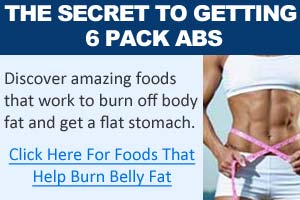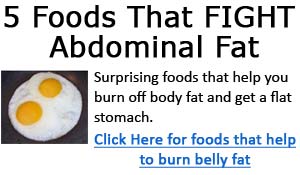If you stop after 20 minutes, you’re only getting half of your workout done! You get the cardiovascular health benefits, but you don’t get much fat loss during the workout. Because you don't burn significant amounts of fat until glycogen stores are depleted, the key to maximum fat loss is to work out aerobically for 30-45 minutes continuously per session. You should do this at least three or four days per week, but five, six, or even seven days a week will take off fat at the fastest rate possible!
Even if you’re doing cardio every day, without a good diet, you still won’t see results. Fat loss is a 50% exercise, 50% nutrition combination. A fat loss diet must be low in calories. Regardless of how much you work out, if the number of calories you take in is greater than the amount you burn, you’ll still put on bodyfat. Ideally, you should spread your calories out into five small meals a day instead of 2 or 3 big ones so that you don’t overeat in one feeding. Eat a variety of foods that are all natural, low in fat and low in sugar, with about 50% of the calories coming from carbohydrates, 30% from protein, and 20% from fat.
If you’re having a really difficult time losing
the last few pounds, keep the protein up and decrease your
carbohydrate intake, especially late in the day and at night.
This will deplete your glycogen stores and force your body
to burn more fat for energy. Be careful not to drop your
calories or carbohydrates too much, because this will be
interpreted by the body as starvation and will result in
a decrease in metabolic rate.
Next to "spot reduction," the second most common
myth about abdominal training is that sit ups and leg raises
are the most effective exercises. Actually, these movements
don’t even isolate the abs; they are integrated exercises
that heavily recruit the hip flexor muscles, which are the
same muscles used to punt a football. The hip flexors attach
the thigh to the spinal column, so working them with exercises
such as straight leg raises creates a strong pull on the
lumbar area. This is a common cause of lower back pain in
those susceptible. There is certainly a place in sports
conditioning for all types of integrated abdominal-hip flexion
exercises. However, a safe, simple and effective way to
for a beginner to started an abdominal program is to emphasize
basic abdominal flexion exercises such as crunches, stability
ball crunches, cable crunches, hip lifts, full range knee
ups and reverse crunches.
 The crunch is simply a partial sit up. You lie flat on
your back and curl your head, shoulders and upper back off
the floor. Your lower back stays on the floor at all times.
This isolates the abs because when the feet are not anchored,
and you don’t sit all the wayup, the hip flexors are
not strongly activated. To add range of motion and activate
your core, the next progression is to perform your crunches
on a stability ball.
The crunch is simply a partial sit up. You lie flat on
your back and curl your head, shoulders and upper back off
the floor. Your lower back stays on the floor at all times.
This isolates the abs because when the feet are not anchored,
and you don’t sit all the wayup, the hip flexors are
not strongly activated. To add range of motion and activate
your core, the next progression is to perform your crunches
on a stability ball.
The reverse crunch, unlike the straight leg raise, is a rolling movement, where the knees are rocked back over the chest. This is a great movement for working the lower abs without putting undue stress on the lower back. To increase difficulty, the next progression is to perform your reverse crunches up a low incline board. To hit the oblique muscles on the sides of the waist, you can do your crunches with a twist (elbow to knee) or you can lie on your side and do side crunches.
The final component of your ab flab-reducing program is resistance training. It is important to train the entire body. Working one muscle group to the exclusion of others is a common cause of muscular imbalance. Building strong abdominals without also developing the antagonistic spinal erectors of the lower back could easily lead to injury. Many people are under the impression that they should only do cardiovascular activities until the weight comes off, then add weight training later on.
It’s true that weight training is an anaerobic activity, so it burns more glycogen than body fat. However, working out with weights will increase your lean body mass, which in turn raises your resting metabolic rate. The faster your metabolism is, the more fat you will burn! A complete program should always include aerobic exercise and weight training for every muscle group.
Before you decide to resort to drastic measures, give these guidelines an honest try. Losing fat is not easy, but it is simple if you know the formula. To recap, the formula for losing the last few pounds of ab flab is as follows: (1) Losing fat takes time, so get started now! Be patient and don’t expect to get "ripped" overnight (2) Burn the fat off the ab muscles with lots of cardiovascular exercise or you won’t be able to see them. (3) Choose biomechanically correct exercises to train the abs, emphasizing crunching type isolation exercises, (4) Eat natural, low fat, low sugar, low calorie foods in small servings throughout the day, and (5) Work out with weights; don’t just train your abs, train your entire body.
>> Click here for Tom Venuto's Burn the Fat Feed the Muscle program

 Developing a lean, flat stomach takes time and patience,
especially when it comes to those last few pounds in those
hard to lose places. The lower abs and "love handles"
can be two of the most stubborn and exercise-resistant areas
from which to lose fat. In fact, it can sometimes seem so
hard to reduce those spots that many people become frustrated
and resort to dangerous diet drugs or liposuction. Other
people slave away day in and day out on the latest new-fangled
ab device or do countless sit ups, side bends, and leg raises
every day, all to no avail. There is only one way to lose
fat in the so-called "stubborn areas," and that
is with the correct combination of proper diet, aerobic
exercise, abdominal training, and weight training.
Developing a lean, flat stomach takes time and patience,
especially when it comes to those last few pounds in those
hard to lose places. The lower abs and "love handles"
can be two of the most stubborn and exercise-resistant areas
from which to lose fat. In fact, it can sometimes seem so
hard to reduce those spots that many people become frustrated
and resort to dangerous diet drugs or liposuction. Other
people slave away day in and day out on the latest new-fangled
ab device or do countless sit ups, side bends, and leg raises
every day, all to no avail. There is only one way to lose
fat in the so-called "stubborn areas," and that
is with the correct combination of proper diet, aerobic
exercise, abdominal training, and weight training. 